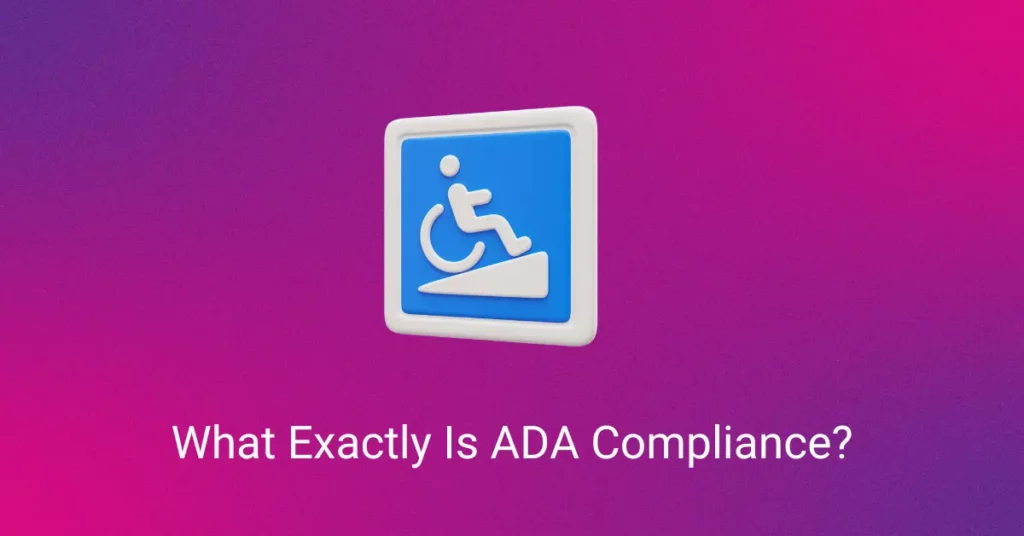Over 40 million people in the United States suffer from disabilities. The Americans with Disabilities Act (ADA) ensures everyone gets equal access to goods and services, including the Internet. Websites and apps are no exception.
So, does your website comply with the ADA?
If not, it might deny equal access to those with visual, cognitive, auditory, or physical disabilities. You may also end up paying hefty fines and face lawsuits for non-compliance with the ADA.
You must, therefore, take measures to comply with the ADA to ensure no one is left behind, no matter what their abilities are.
Before we get into how to make your website ADA-compliant, we must first conceptually understand what ADA compliance even means
What is ADA compliance?
The Americans with Disabilities Act was initiated in 1990 to end discrimination against disabled individuals in sectors like education, transportation, and telecommunication. Organizations were directed to offer “reasonable accommodations” for people with disabilities and grant them equal rights and opportunities.
The revolutionary ADA led to the development of accessible restrooms, wheelchair access ramps, use of braille, and other accessible locations across America.
In 2010, the US Department of Justice passed the Americans with Disabilities Standards for Accessible Design. It mandated all electronic and information technology be accessible to users with disabilities.
When it comes to websites, ADA compliance refers to making your online services and content accessible to every user. You can provide alternative text for images, keyboard navigation support, captioning videos, keyboard accessibility, and more to ensure inclusivity.
Who is required to follow the ADA requirements?
After understanding what is ADA compliance, you must also find out if the act applies to you in the first place. The ADA is applicable to businesses and organizations that come under the following:
- Title I: Title I of the act covers businesses operating for twenty or more weeks in a year and have a minimum of 15 full-time employees.
- Title II: Title II includes the state and local government services and programs.
- Title III: Title III covers businesses under the “public accommodation” category like hotels, banks, public transportation, restaurants, etc.
If your business comes under Title I and III, you need to comply with the ADA standards. The law applies to both physical as well as digital accommodations. However, it is important to note here that making your website ADA accessible is still encouraged even if your company doesn’t fall under the above categories.
How to verify the ADA compliance of your website?
To check ADA compliance for your website, you must ensure your site is accessible to people with visual, auditory, cognitive, and motor impairments.
Here’s how you can verify if your website is adhering to ADA standards:
- You first need to understand the ADA standards and Web Content Accessibility Guidelines (WCAG)
- Use accessibility evaluation tools like Web Accessibility Evaluation Tools (WAVE)
- Manually test your site for various assistive technologies such as keyboard navigation, screen readers, etc.
- You can use web accessibility plugins like the ones for WordPress websites
- Perform accessibility audits regularly to identify new issues
What happens if your website is not ADA-compliant?
A website not complying with ADA standards can land into serious trouble. You have to pay fines of up to $55,000-$75,000 for a first-time offense. In case of repeated violations, you may need to pay $1,50,000.
Failure to comply with ADA standards can also expose your business to lawsuits and hamper your brand reputation. Some brands named in lawsuits include The Wall Street Journal, Hershey’s, Amazon, Rite Aid, H&R Block, and Teacher’s Test Prep.
Your company can also face legal troubles for not complying with the ADA, even if it is not popular. You must, therefore, invest your time and resources to make your site accessible to every individual, irrespective of their abilities.
What specifications must an ADA-compliant website meet?
While the US Department of Justice has not specified the ADA compliance guidelines, many organizations and businesses follow the Web Content Accessibility Guidelines (WCAG) to ensure accessibility. WCAG is not legally mandated, but you can use it as a reference source to adhere to ADA standards.
You can also refer to the standards stated in Section 508 of the Rehabilitation Act of 1973 to make your website ADA accessible.
How to make your website ADA compliant?
WCAG has the following levels of conformance and many organizations recommend meeting at least the AA level of compliance to adhere to the ADA:
- A – Bare minimum level of accessibility
- AA – Target level of accessibility complying with legal requirements
- AAA – Exceeding accessibility compliance
You can follow the WCAG 2.1 guidelines to make your website more accessible for users with disabilities. It has the following core principles:
Perceivable
You should make your website perceivable by providing alternatives to accessibility. It means every user must be able to perceive your site’s information, like text, videos, and images, easily. You can provide visually impaired users the choice to listen to a text. Or you can use closed captioning for users with a hearing disability.
Operable
Your website should be operable. It means every user must be able to operate and navigate your site without any obstacles. For this, you can provide keyboard accessibility. It can help people with disabilities smoothly navigate and access your website information.
Understandable
Your website content should be understandable. From images, videos, texts or tools, every user must be able to comprehend your site’s content. You can provide input assistance to help people with disabilities enter the correct information, especially when filling out forms.
Robust
Your website content should be compatible with various devices, platforms, and assistive technologies. For instance, users reading your site content and ones using a voice reader should be offered a similar experience.
Conclusion
Meeting the ADA requirements can not only improve your site’s accessibility to users with disabilities but also widen your business reach and help you tap into a larger market. Following these standards to at least an AA level of compliance can also save you from fines and legal troubles.
Finally, web accessibility is not only legally mandated. It is essential for creating a truly inclusive digital environment that offers equal rights and opportunities to people with disabilities.
FAQ
What is ADA?
The Americans with Disabilities Act (ADA) of 1990 is an American civil rights law. It strives to end discrimination against disabled individuals in all public spaces, including the electronic and information technology sector. The act ensured people with disabilities enjoyed equal rights and opportunities and led to the development of accessible restrooms, wheelchair access ramps, and other accessible locations across America.
Is ADA the same as Section 508?
No, ADA and Section 508 are not the same. Section 508 of the Rehabilitation Act is an accessibility law that applies to federal agencies or those receiving federal employment or aid. On the other hand, ADA applies to state and local governments as well as businesses open to the public. However, the US Department of Justice recommends Section 508 to meet ADA requirements.
Is ADA the same as WCAG?
No, ADA and WCAG are not the same. WCAG are accessibility standards developed by the World Wide Web Consortium (W3G). it aims to provide a single standard for web content accessibility that fulfills the needs of every individual, organization, and government globally. WCAG explains how to make web content accessible to users with disability. These standards are published by the Web Accessibility Initiative (WAI) of the W3G.
Popular Searches
How useful was this post?
0 / 5. 0














